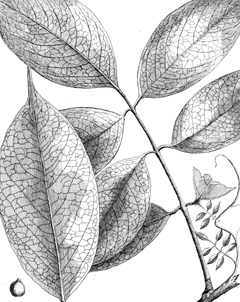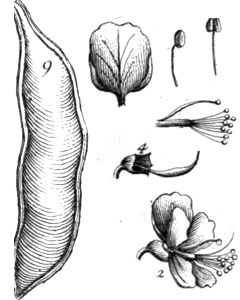 |
|
https://edibleplants.org/ |
 |
| https://edibleplants.org/ |
Translate this page:
Summary
Deguelia utilis is an evergreen climbing shrub or small tree. It is one of the sources of rotenone, an organic insecticide used as a fish and ant poison. It is commonly found in South America. It has a symbiotic relationship with a certain soil bacteria that forms nodules on the roots and fixes atmospheric nitrogen.
Physical Characteristics

 Deguelia utilis is an evergreen Tree growing to 15 m (49ft) by 15 m (49ft) at a medium rate.
Deguelia utilis is an evergreen Tree growing to 15 m (49ft) by 15 m (49ft) at a medium rate.
See above for USDA hardiness. It is hardy to UK zone 10. The flowers are pollinated by Insects.
It can fix Nitrogen.
Suitable for: medium (loamy) and heavy (clay) soils and prefers well-drained soil. Suitable pH: mildly acid and neutral soils and can grow in very acid soils.
It can grow in full shade (deep woodland) semi-shade (light woodland) or no shade. It prefers moist soil.
UK Hardiness Map
US Hardiness Map
Synonyms
Derris nicou auct Derris utilis (A.C.Sm.) Ducke Lonchocarpus nicou auct Lonchocarpus nicou utilis (A.C.Sm.) A.M.G.Azevedo
Plant Habitats
Edible Uses
References More on Edible Uses
Medicinal Uses
Plants For A Future can not take any responsibility for any adverse effects from the use of plants. Always seek advice from a professional before using a plant medicinally.
The plant contains some compounds similar to curare. Traditional healers crush the bark until a white milky substance exudes, they take one spoonful of this and retire. Twenty-four hours later they relate their visions to the tribes people[ 748 ].
References More on Medicinal Uses
The Bookshop: Edible Plant Books
Our Latest books on Perennial Plants For Food Forests and Permaculture Gardens in paperback or digital formats.

Edible Tropical Plants
Food Forest Plants for Hotter Conditions: 250+ Plants For Tropical Food Forests & Permaculture Gardens.
More

Edible Temperate Plants
Plants for Your Food Forest: 500 Plants for Temperate Food Forests & Permaculture Gardens.
More

More Books
PFAF have eight books available in paperback and digital formats. Browse the shop for more information.
Shop Now
Other Uses
References More on Other Uses
Cultivation details
A plant of the moist, lowland tropics, usually in areas with year-round rainfall. Succeeds in moderate sun to fairly deep shade so long as the top growth can climb towards the light. Prefers a neutral to acid soil, usually found on more or less clay soils in the wild[ 748 ]. In some areas where it grows it is subject to periodic inundation of the soil[ 748 ]. Some forms of this plant do not produce seed, probably as a result of long term cultivation with propagation by cuttings[ 748 ]. This species has a symbiotic relationship with certain soil bacteria, these bacteria form nodules on the roots and fix atmospheric nitrogen. Some of this nitrogen is utilized by the growing plant but some can also be used by other plants growing nearby[].
References Carbon Farming Information and Carbon Sequestration Information
Temperature Converter
Type a value in the Celsius field to convert the value to Fahrenheit:
Fahrenheit:
The PFAF Bookshop
Plants For A Future have a number of books available in paperback and digital form. Book titles include Edible Plants, Edible Perennials, Edible Trees,Edible Shrubs, Woodland Gardening, and Temperate Food Forest Plants. Our new book is Food Forest Plants For Hotter Conditions (Tropical and Sub-Tropical).
Shop Now
Plant Propagation
Seed - Cuttings root easily[ 748 ].
Other Names
If available other names are mentioned here
barbasco, cube, timbo nicou - French, barbasco -Spanish.
Native Range
SOUTHERN AMERICA: French Guiana, Guyana, Suriname, Venezuela, Brazil (Acre, Amazonas, Pará), Colombia (Meta, Amazonas), Ecuador (Napo), Peru (Amazonas, Ayacucho, Junín, Loreto, Madre de Dios, San Martín)
Weed Potential
Right plant wrong place. We are currently updating this section.
Please note that a plant may be invasive in one area but may not in your area so it's worth checking.
Conservation Status
IUCN Red List of Threatened Plants Status : This taxon has not yet been assessed.

Growth: S = slow M = medium F = fast. Soil: L = light (sandy) M = medium H = heavy (clay). pH: A = acid N = neutral B = basic (alkaline). Shade: F = full shade S = semi-shade N = no shade. Moisture: D = dry M = Moist We = wet Wa = water.
Now available:
Food Forest Plants for Mediterranean Conditions
350+ Perennial Plants For Mediterranean and Drier Food Forests and Permaculture Gardens.
[Paperback and eBook]
This is the third in Plants For A Future's series of plant guides for food forests tailored to
specific climate zones. Following volumes on temperate and tropical ecosystems, this book focuses
on species suited to Mediterranean conditions—regions with hot, dry summers and cool, wet winters,
often facing the added challenge of climate change.
Read More
Expert comment
Author
(A.C.Sm.) A.M.G.Azevedo
Botanical References
Links / References
For a list of references used on this page please go here
A special thanks to Ken Fern for some of the information used on this page.
Readers comment
| Add a comment |
|
If you have important information about this plant that may help other users please add a comment or link below. Only comments or links that are felt to be directly relevant to a plant will be included. If you think a comment/link or information contained on this page is inaccurate or misleading we would welcome your feedback at [email protected]. If you have questions about a plant please use the Forum on this website as we do not have the resources to answer questions ourselves.
* Please note: the comments by website users are not necessarily those held by PFAF and may give misleading or inaccurate information.
To leave a comment please Register or login here All comments need to be approved so will not appear immediately.
|
Subject : Deguelia utilis
|
|
|
|